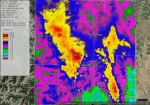Thursday, April 10th, 2014
By now many of us know the important role of polar-orbiting satellites in providing advanced warning for severe weather, but how about their role during non-weather disasters? Last month marked the 25th anniversary of the Exxon Valdez spill, when shortly after midnight on March 24, 1989, the tanker Exxon Valdez grounded on Bligh Reef in
Friday, March 21st, 2014
Scientists using passive acoustic monitoring to track minke whales in the Northwest Atlantic have found clues in the individual calling behaviors and movements of this species. These findings, recently published online in the journal Behaviour, provide insight into one of the least studied baleen whales.
Tuesday, January 21st, 2014
The same NOAA satellites that helped forecasters predict severe weather, such as the Moore, Okla., tornado last May and November’s deadly Midwest tornado outbreak, also played a key role in rescuing 253 people from potentially life-threatening scenarios throughout the United States and its surrounding waters last year.
Friday, November 22nd, 2013
A glowing six-foot diameter sphere, suspended from the ceiling of NOAA headquarters in Silver Spring, Md., is the 100th Science On a Sphere installed around the world. The 3-D display system, which was unveiled today, illuminates awe-inspiring animations of planet Earth and is used by educators, curators and scientists alike to explore global environmental data,

Sunday, November 10th, 2013
On September 10, 2013, what would become a devastating situation, began with an inch of rain falling in Boulder, Colorado. The following day saw another inch, and the rain continued to come down for several more days after that. Only six days later on September 16, some Community Collaborative Rain, Hail, and Snow Network (CoCoRaHS)
Sunday, October 27th, 2013
NOAA’s Office of Coast Survey, which creates and maintains the nation’s suite of over a thousand nautical charts of U.S. coastal waters, today announced major changes ahead for mariners and others who use nautical charts. Starting April 13, the federal government will no longer print traditional lithographic (paper) nautical charts, but will continue to provide
Friday, September 13th, 2013
Coastal ocean stakeholders in the U.S. Caribbean now have new data available to inform decision making. The Caribbean Coastal Ocean Observing System (CariCOOS), under the auspices of the Caribbean Regional Association for Coastal Ocean Observing, a regional member of the U.S. Integrated Ocean Observing System (IOOS), deployed the region’s fifth data buoy today.
Friday, September 13th, 2013
NOAA announced the release yesterday of a comprehensive, quality-controlled dataset that gives ready access to millions of chemical analyses and other data on the massive Deepwater Horizon Oil Spill. The dataset, collected to support oil removal activities and assess the presence of dispersants, wraps up a three year process that began with the gathering of
Tuesday, September 10th, 2013
A fleet of underwater robots is descending into waters off the east coast to collect data that could help improve storm intensity forecasts during future hurricane seasons. Several regions of the NOAA-led U.S. Integrated Ocean Observing System (IOOS®) are partnering to deploy 12 to 16 autonomous underwater robotic vehicles, also known as gliders, from Nova
Tuesday, September 10th, 2013
NOAA’s Office of Response and Restoration has launched a new online mapping tool for the Great Lakes that will give decision makers, resource managers, and environmental responders better information as they clean up hazardous materials and restore the coastal and estuarine environments.